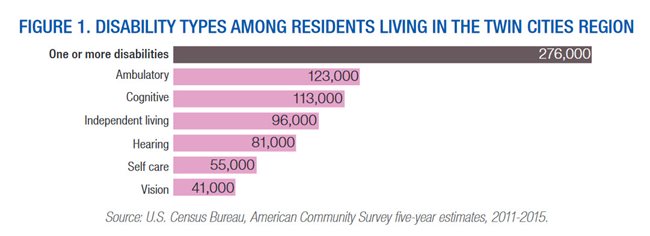A new Council MetroStats research report finds that people with disabilities have fewer opportunities for employment, housing and economic well-being.
The report, “Understanding Disparities by Ability Status in the Twin Cities,” finds:
-
1 in every 11 residents reports at least one disability.
-
People with disabilities are less likely to be in the labor force, more likely to report lower incomes, and more likely to live at or near poverty levels.
-
People with disabilities’ housing choices may be limited due to their economic profile; they are more likely to be housing cost burdened—that is, paying more than one-third of their income on housing.
According to the U.S. Census Bureau, American Community Survey 2011-2015, about 276,000 people with disabilities live in the Twin Cities region, about 9% of the region’s total population. The Census Bureau collects information on six types of difficulties: hearing, vision, cognitive, ambulatory, self-care, and independent living.
Failure to address disparities of all sorts, Council officials say, threaten the region’s livability and prosperity.
Types of disabilities among region's residents

Earnings by ability status

Disparities will grow as the region ages
The share of people with disabilities in the region’s communities ranges from 21% in Oak Park Heights and Lilydale to 2% in Elko New Market. Many communities with higher concentrations of people with disabilities are in the core of the region where public transportation and services may be more accessible.
These communities include Saint Paul (12%), Minneapolis (11%), and several first-ring suburbs. Not surprisingly, communities with higher shares of residents who are 65 or older also have high shares of people with disabilities. Oak Park Heights (21%), Lilydale (21%), Anoka (17%), Osseo (16%), and Little Canada (15%) are among these communities.
The prevalence of disabilities increases as people age. The overall prevalence of people with disabilities in the region is likely to increase as the region’s demographic profile changes.
According to the most recent regional forecast, the number of residents who are 65 or older will double between 2010 and 2030, and the share of residents who are 65 or older will go from 13% in 2015 to 22% in 2040. If the likelihood of disability by age does not change, the region will have around 465,000 adults with disabilities in 2040—around 60% more than today.
More information
See the full MetroStat report Understanding Disparities by Ability Status in the Twin Cities (pdf).